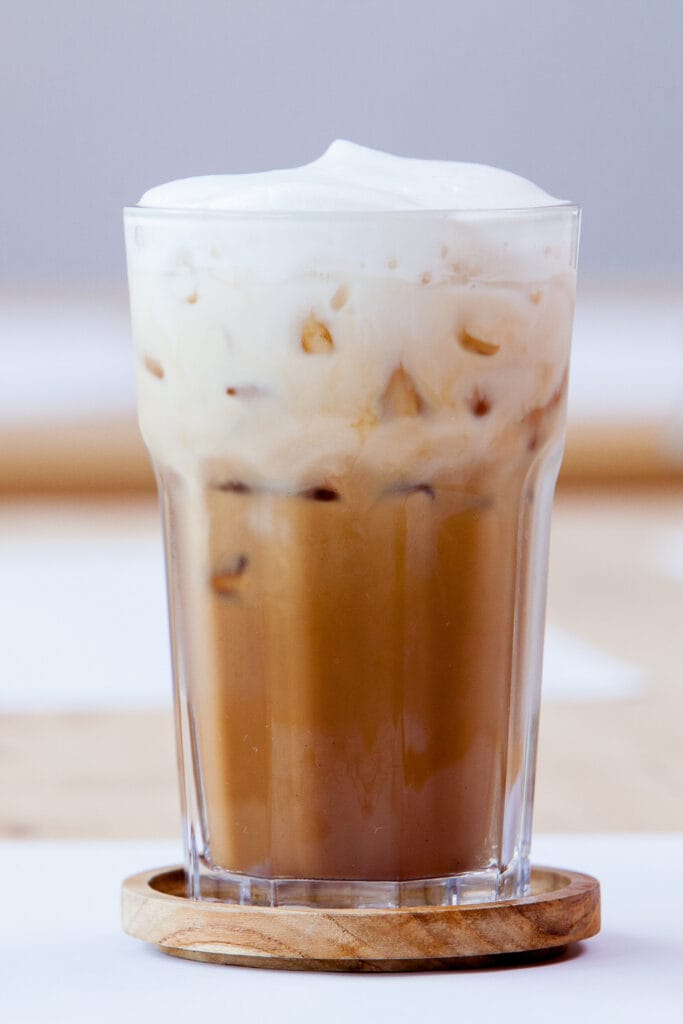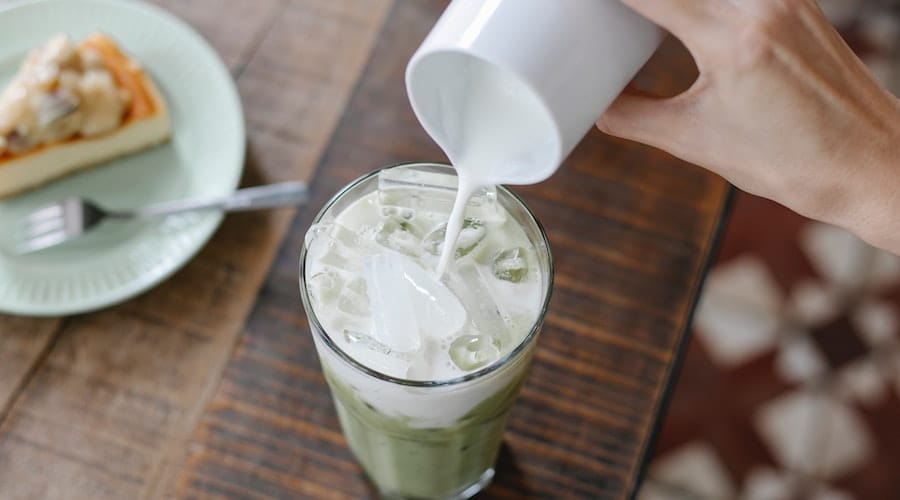Iced coffee has been around since the 1800s, but its popularity has skyrocketed in recent years!
The break from tradition that characterizes the iced latte and flat white can make them a little difficult to tell apart.
As we’ll see, iced lattes and flat whites can be quite different from their warmer counterparts!
Whether you’re an aspiring barista or just tired of bluffing your way through your coffee order (we’ve all been there), you’ll want to know what distinguishes them. In this guide, we’ll explore:
- The iced flat white, what makes it special, and how to make it at home
- How the iced latte differs
- In-depth similarities and differences between the two
- Customization options for both.
We’ll also answer some frequently asked questions about the two beverages. Let’s get into it!
Exploring the Iced Flat White
Ingredients and Composition
In the strictest case, an iced flat white is simply a flat white made over a glass of ice.
However, iced coffees aren’t known for adhering to tradition! There is no universal recipe for the iced flat white, but one of the things that makes it a flat white is the higher ratio of coffee to milk.
Around one-third of a regular flat white should be strong espresso, and two-thirds should be microfoamed milk.
Flavor Profile and Variations
The flat white is aptly named; it’s a smaller, denser, visibly flatter drink made by pouring microfoamed milk over two ristretto shots to add a simple, creamy layer without masking the rich flavor of the coffee.
This is a nice middle ground between pure espresso and a milk-heavy option like a latte.
Brewing the Perfect Iced Flat White at Home

To brew an iced flat white at home, try a variation of the following:
- Fill your cup with ice cubes. Most people prefer to use a glass
- Pull two separate ristretto shots and pour them into your glass. What defines a ristretto shot is the ratio of coffee to water. This is a stronger, thicker, richer shot, containing equal amounts of coffee grinds and water. To pull a ristretto shot, simply prepare a regular espresso shot and pull for half the usual time
- Microfoam a half jug of milk with your coffee machine’s (clean) steam wand. You should aim to heat the milk to no more than 65 degrees Celsius (or 149 degrees Fahrenheit).
- The heat helps create the foaming effect, but excessive heat will lead to milk separation. The steam wand should be facing away from you at an angle, sitting just to the side of the center to create a vortex.
- You should only steam near the surface for around two seconds, as this brings air into the milk – and we only want a little! After that, steam deep beneath the surface for another two seconds before gently tapping the jug on your benchtop.
- This process removes and prevents larger air bubbles in your milk, resulting in the denser milk foam characteristic of the flat white.
- Pour your microfoamed milk into your glass and serve!
In less traditional variations of the iced flat white, the microfoaming process is skipped or regular steaming is used instead.
Some people prefer to microfoam the milk before pouring the ristretto, allowing it to cool down in the refrigerator while the shots are pulled.
Delving into the Iced Latte
Ingredients and Composition
The latte is a somewhat similar brew, and some even go as far as to suggest that the flat white is just a “smaller latte”.
There’s a grain of truth to this hyperbole, especially when it comes to the iced varieties.
A more traditional iced latte’s ice and espresso are topped with a similarly large layer of steamed milk rather than microfoamed milk.
The second espresso shot is optional, and the espresso isn’t necessarily of that stronger ristretto variety.
A third layer of regular milk foam on top is compulsory in the traditional case, making for a milkier drink that isn’t so ‘flat’.
Flavor Profile and Variations
Of course, like the iced flat white, the iced latte often breaks from tradition!
Different recipes aside, what makes this drink a latte rather than a flat white is its higher ratio of milk to coffee. The result should be a milder alternative to the iced flat white.
Most of the latte fans that I know consider themselves ‘sweet tooths’ and focus more on the overall drink than the coffee roast used.
Creating an Iced Latte at Home

Creating an iced latte looks a lot like creating an iced flat white. Instead of pulling two ristretto shots, pull one to two regular espresso shots and pour that over the ice.
Then, if you want to stay traditional, add a large layer of steamed milk followed by a small, rounded layer of regular milk foam. In some recipes, you don’t even heat the milk!
If you are steaming your milk, the process is a lot like the microfoaming. In fact, the foamier milk that develops on top of steamed milk is microfoam. When making steamed milk, we just don’t want to turn all the milk into microfoam.
To create your milk foam topping, you can once again use the steam wand.
Alternatively, you can use a handheld milk frother, whisk, or a French press. If you’re using a steam wand, the process is once again like microfoaming your milk!
Use less milk, as you’re only making a small layer, and don’t worry about large air bubbles in the milk – the foam should be a lot airier than the layer of steamed milk.
When the foam is to your liking, pour it over the latte and enjoy! If you’re instead creating your foam by hand, it’s a pretty straightforward process and my local barista recommends it for most people.
Also Read: Iced Cappuccino vs. Iced Latte: What Are the Differences?
Comparing the Cold Coffees: Iced Flat White vs Iced Latte
Texture and Mouthfeel
The regular espresso and a higher proportion of milk combine with the more traditional, airy milk foam topping of the iced latte to soften the drink.
This contrasts with the immediately thicker, creamier texture of the iced flat white.
In New Zealand and Australia, both of which claim to have invented it, the flat white is widely known as a ‘no-nonsense’ drink – a simple coffee with some textured milk, typically lacking any additional layer of foam.
Flavor and Strength
You’ll prefer the flat white over the latte if you’re looking for something a little stronger.
The flat white typically uses medium or darker roasts for a stronger flavor, while the milkier iced latte usually pairs quite well with a medium roast. The key to the latte is that subtler coffee flavor.
Caloric Content and Nutritional Differences
Not only does the flat white taste stronger, but it kicks a bigger punch when it comes to caffeine.
The two ristretto shots in a typical cup amount to an impressive 130mg of caffeine!
Individuals who are sensitive to caffeine may want to opt for a single-shot iced latte, which typically contains a more modest 77mg of caffeine.
The lower caffeine option may also be preferred by those who drink more cups in a day.
It’s usually recommended that you don’t exceed 400mg of caffeine in a single day, and that number may be lower for some individuals.
If you are looking for an extra buzz, an iced latte sometimes comes with multiple shots (and some recipes even use ristretto). It’s easy to see how these two drinks can get confused.
When it comes to calories, it all depends on the kind of milk used and any additions made to your drink.
Full-fat milk is more caloric than skim milk, which is often more caloric than plant-based milk. Syrups are often high in sugar, so some people opt for a low-calorie artificial sweetener.
Customization and Personalization Options
Syrups, Sweeteners, and Toppings
While it’s more popular in the iced latte, sugar, flavored syrups, and other ingredients are often added to both beverages to create a sweeter or more unique flavor.
Popular flavor options include caramel, vanilla, hazelnut, cream, chocolate, and cinnamon.
Milk Alternatives and Adjustments
If you’re looking for plant-based or otherwise alternative milk, there are options. Oat, almond, and soy are three popular milk options for those who are avoiding dairy.
Oat milk may be a good option for those who wish to create a more traditional version of the latte because it has a similar texture and flavor to dairy milk and is relatively easy to steam with similar effects.
Soy milk may be preferred when brewing a more traditional iced flat white, as it’s the proteins and fats in dairy milk that maintain the foamy structure and soy milk is a higher protein plant milk. Oat milk is usually still effective – so if in doubt, opt for oat milk!
Note that different milk options will require different temperatures and frothing techniques for the desired effects.
Frequently Asked Questions
The iced flat white is smaller, stronger, and less foamy than an iced latte.
The flat white is usually stronger, although the caffeine content of the latte is more variable and can be just as strong.
Both the iced latte and the iced flat white come in non-dairy varieties. Oat milk is a very safe option to try.
Typically, the iced latte is sweeter, as the flat white is a characteristically stronger coffee. However, both may be sweetened with customization.
A 2023 report found the latte to be more popular, although the flat white is very well-loved in its own right (particularly in Australia and New Zealand).